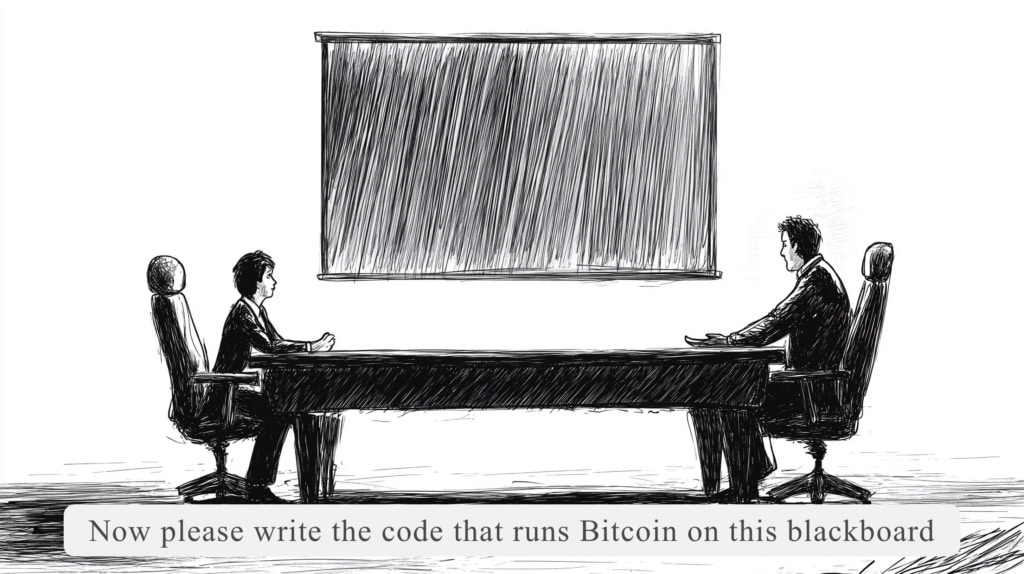Navigating the Tech Industry Hiring Process in 2024
As a freelancer, I’ve experienced a wide variety of hiring processes. My work often involves acting as a “hired gun”, collaborating closely with companies of various sizes during intense initial software development phases. These engagements can last anywhere from a month to a year, meaning I switch “jobs” quite frequently.
Throughout my career, I’ve encountered all kinds of hiring practices, from in-depth 4-5 stage processes to quick, single interview and portfolio checks, and everything in between. The effectiveness and time consumption of these methods vary greatly.
Recently, I’ve been hearing that finding a job in the tech industry has become more challenging.
Many people feel lost in the complex hiring processes that have become common in the sector. The competition is fierce, and the requirements seem to be ever-increasing. This can be particularly daunting for newcomers to the industry or those switching from other fields.
In this article, I’ll try to demystify the different possible stages of the tech hiring process. My goal is to help you feel less lost and more prepared as you navigate your job search. By understanding what to expect at each stage, you can better prepare yourself and increase your chances of success.
So, what exactly are the common hiring practices and how do they flow from stage to stage? Also, what’s the purpose of each stage? Let’s look at tech sector hiring practices a bit more closely.
Hiring Process
In the world of software development, the hiring process is a unique and often complex affair. Many software companies function as human resource providers, essentially selling the skills of their employees to clients. This business model shapes their approach to hiring and managing talent in special ways.
At the heart of this process is a philosophy often summarized as “Hire fast, fire fast.”. This approach reflects the nature of the industry, where a company has to filter out the most productive people at all times. To support this philosophy, software companies typically maintain larger HR departments than you might find in other industries.
The goal for these companies is to hire developers whose work can be sold for several times their salary, often more than 10 times or even more.
This markup is the key to company’s profitability, which explains why so much effort goes into the hiring process. As a result, job candidates often find themselves navigating a highly structured, well-documented process that can feela lmost mechanical.
However, this often leads to hiring processes that are more complicated than necessary. With numerous HR personnel involved and high stakes for each hire, the process can become bloated. this has given rise to a common industry joke that software companies hire “like they’re selecting a president for a janitor’s job”.
Skills tested during hiring and those required for the actual job can become totally disconnected.
Candidates might be given complex algorithmic problems or intricate coding challnges, only to find that their day-to-day work involves much simpler tasks like tweaking small parts of user interfaces or implementing very basic features.
For those aspiring to enter the software development field, understanding this landscape can be invaluable. It helps set expectations and allows candidates to better prepare for the sometimes bewildering process of landing their first job in the industry. Despite it’s quirks and potential frustrations, this hiring process is desicnged to identify talented individuals who can thrive in the fast-paced, ever-changing world of software development.
The First Interview: Your Initial Handshake
Congratulations. Your CV has piqued the company’s interest and you’re now up for the first round: a video interview with an HR representative. Think of it as a digital handshake – quick, but crucial. It’s the company’s way of checking if you pass the initail ‘vibe check’ and could potentially fit into their corporate family. This interview is typically a one-person show from the company’s side. The HR rep will do most of the talking.
Your job is to smile, nod and answer questions without spilling coffee on your keyboard.
The tone can range from robotic to warm and fuzzy, depending on the company culsture and the HR person’s personality.
The HR rep will start with company introduction, giving your the overview of their size, products, services and a broad outline of the role you’re applying for. Then it’s your turn to talk and introduce yourself. They do have your CV in front of them, but you’ll need to give them the elevator pitch version of your professional life story, skills and superpowers. It’s also chance to set the tone – try to keep it rather light and friendly if you can.
Once introduction is over you’ll have the opportunity to ask questions. While it’s not the time for deep dive, it’s a good idea to voice initial concerns and curiosities about the role. Remember that you’re not just being interviewed – you’re also interviewing them. If something doesn’t feel right, speak up. Also it’s a good idea here to give regards to the company and compliment them giving them idea on why exactly you want to be employed there.
Some companies like to make a quick quiz section near the end. These can feel like you’ve suddenly been teleported onto a game show. The HR person will read you a question they can barely understand themselves. It usually feels mechanical as it’s coming from a script provided by the tech team. Try to reply to the best of your knowledge and don’t mind if you don’t know all the answers.
Also, at this point the HR rep might ask you for your expected compensation. While there are tricks and ways for you to linger out of exposing that information, it would be possible if you would just state a number you will be very very happy to work with the company. Remember, this is your chance to set the bar high – it’s easier to negotiate down than up later in the process.
Finally the HR representative will outline the next steps in the hiring process and what to expect next.
Remember, the first interview is just the beginning. It’s your chance to make a good first impression and also decide if this is the company you want to spend your time with. So put on your best webcam-friendly outfit, check your microphone and get ready to charm your way into the next round.
The Technical Assessment: Proving Your Coding Chops

If you made it past the initial screening and the HR person thinks your vibe is right, then you will enter the next stage of the hiring game: the technical challenge. This is the part where the company tries to figure out if you can actually do what your resume claims you can.
The technical challenge can take various forms, depending on the company and the role you’re applying for. Some common approaches are as follows:
Technical Interview
A traditional interview format, but focused entirely on technical questions. Usually conducted by a few programmers who are in your future teams. You might be asked more details about your past projects, quizzed on programming concepts, or asked to solve theoretical or real-world problems.
Sometimes these interviews are a mix between live coding sessions (mentioned below) and person-to-person interviews between you and future team members.
Take-Home Project
A very common practice among software companies. You’ll be given a project to work on in your own time. This could involve building a small application or solving a series of related problems relevant to your post. It’s possible that you’ll be given a sample project which has bugs for you to fix. While this gives you more time to showcase your skills, it can also be time-consuming. Make sure you’re prepared to invest the effort.
It’s a good idea here to really provide the best code structure you can and go the extra mile if possible. For a small application, make sure you also write tests for your code, even if it’s not specified in the assignment.
Coding Challenge
You might be given a problem to solve, usually through an online platform. This could be anything from implementing a specific algorithm to building a small application. The key is not just getting the right answer, but showing clean, efficient, and well-documented code.
Note these challenges can become very complex and make you feel like you’re in a math class again, so if you can, try to take them when you’re feeling fresh and energized.
Live Coding Session
This is usually similar to a coding challenge, where you’ll be asked to solve coding problems, but it will happen in real-time, often while sharing your screen with the interviewer. It’s not just about getting the right answer, but also about demonstrating your problem-solving process and how you can handle pressure. Most of the time you can use search engines or AI tools of your choice, and it’s a good place to show your googling or prompting skills.
This is quite a nerve-wracking type of technical assessment, especially when taking into consideration the introverted nature of most programmers.
Whiteboard Interview
A less common method, but some companies might use this approach. You’ll be asked to solve problems by writing code on a whiteboard or shared digital workspace. You won’t be able to use AI or search engines to do this, but rather reason and show off your logic and syntax skills.
This is the worst type of technical interview. Even the best coders still ask AI or Google about simple things. So you’ll have to be very confident to enter into one of these interviews.
The goal of this phase isn’t just to test your coding skills. The interviewers are also looking at how you approach problems, how you communicate your thoughts, and how you handle feedback or hints. They’re trying to imagine what it would be like to work with you on a daily basis.
Don’t be surprised if you’re asked to explain your thought process or defend your choices. This is your chance to show not just what you can do, but how you think. And if you get stuck, don’t panic. How you handle challenges can be just as important as solving the problem perfectly.
If you’re given a take-home project or coding challenge, make sure you read the instructions carefully. There’s often important information hidden in the details, and following instructions accurately is a key skill in software development.
The Team Interview

Not many applicants get this far, but if you do you’ve aced on coding challenge and the company is now very interested in hiring you for the post. This phase is about figureing out if you’ll be a good fit in the existing team and company’s culture.
In this interview you can expect:
- Meet the team: You’ll interact with potential future colleagues. Developers, project managers and maybe even executieves in smaller companies. This isn’t just for show, but they’ll want to see how you communicate and if you can hold your own in a team setting.
- Behavioural Questions: Prepare for questions like “Tell me about the time you had a conflict with team member” or “How to handle tight deadlines?”. Your answers will elaborate more on how you solve real-world problems.
- Informal Chat: Often this interview is more casual. Maybe over lunch or coffee. It’s a good place to let your personality shine through, but still keeping it professional.
- Your questions: This is the time you can ask questions about team dynamics, company culture and everyday life int he company. Note that you’re interviewing them as much as they interview you.
The key in this phase is be yourself as much as you can.
The company is now sure you have the skills for the job and now they want to know if you’re someone they enjoy working with every day.
Show enthusiasm, ask well formed questionas and let them you know you’re not looking for any job, but the exact job they have to offer at that moment.
The Final Stretch: The Offer, Negotiation and Contract
After the team interview goes well, you’re in the home stretch. This part is not so much an interview, but rather a back-and-forth offer negotiation phase of the hiring process.
It will start with the job offer. This usually comes as an email with an attached document which includes:
- Salary details
- Benefits package
- Start date
- Job title and description
- Any special terms and conditions
Don’t feel pressured to accept on the spot. It’s perfectly acceptable and often expected to ask for some time to review the offer and enter into negotiations about its terms.
Negotiation is where your diplomacy skills come into play. If you’re not satisfied with some aspects of the offer, this is your chance to negotiate about the salary, benefits, or you can request flexible working hours and remote work options.
This is a normal part of the process. Be professional and back up your requests with solid reasons, and be prepared for some back-and-forth communication.
Once you come to an agreement about the job, you’ll be presented with the contract, possibly some tax forms, and non-disclosure agreements. Read everything carefully before signing. If something isn’t clear, don’t hesitate to ask for clarification.
Onboarding
The final part of the hiring process is onboarding. This will be an overwhelming part of the process.
Your first day will be an array of introductions, paperwork, and enough terminology to make your head spin. You’ll probably meet HR again to sort out any remaining administrative tasks. Don’t worry if you can’t remember everyone’s names or what YJCE stands for; it’s all part of the process.
About remembering names, I suggest you keep a notes document open on your phone. When finished talking with people, try to write down names and positions for all of the people you met. It might become very useful in the next couple of days.
Next, you’ll be spending some time with the IT department. They’ll set you up with a computer, company email, and access to all necessary software and tools you’ll need for your job.
At some point, you’ll be introduced to the company’s code base. This can feel like being dropped into a jungle with only a plastic spoon for navigation. Don’t panic! Nobody expects you to understand everything immediately. Take notes, ask questions, and remember: even senior developers are sometimes lost in this GitHub repo.
Onboarding is also the part of the process where you’ll meet other team members. This could include other developers, QA testers, UX designers, project managers, and product owners. Remember the trick about remembering names here too. These are the people you’ll be spending most of your upcoming time with. Be friendly, but don’t worry if you don’t click with everyone immediately.
Personal Insights on the Hiring Process
In today’s global workforce, technical challenges have become necessary. However, as the hiring process is typically unpaid, I’m wary of investing too many hours in what I call the “hiring carousel”.
While 2-3 meetings are fine, homework assignments or extensive challenges can be frustrating. I generally decline these gracefully. I do, however, enjoy technical interviews where I can comment on code in real-time, discuss alternative approaches with the tech team, or debug an application if needed.
Technical interviews, in my opinion, provide the best overview of a person’s thinking process without wasting the applicant’s time.
One aspect of the hiring process that I find problematic is its unpaid nature. Spending days on a homework assignment (despite companies often claiming it will only take a few hours) without compensation feels unfair. I believe that after passing initial screenings, companies should consider compensating candidates for the time invested in technical homework. Too often, I’ve gone through extensive processes involving cover letters, technical challenges, and multiple interviews, only to be rejected.
I feel that paying to candidates who reach later stages would be fair.
As I’ve also been the one reviewing the homework assignments from applicants, I have to admit that the effort that applicants put in doesn’t really match the value and information I get from reading and understanding their code and work processes.
In my experience, quizzes and whiteboard interviews are often ineffective as well, especially for introverted developers who think and work best alone. Bombarding candidates with questions about terminology and specific syntax structures can give a distorted impression of their skills. A talented architect or programmer might excel at designing large systems but struggle in a high-pressure interview setting.
Lastly, it’s crucial to remember that many job seekers are in vulnerable positions, which can lead them to accept suboptimal offers. My advice is to avoid this situation if possible (by having “f*** you” money in the bank). But if you are in this position, then at least project confidence.
The interview process is as much about you evaluating the company as it is about them evaluating you.
If you sense arrogance or bullying from an HR representative during the initial interview, it’s likely indicative of the company culture. Don’t hesitate to voice your concerns or decline opportunities if you get a bad vibe.
I’ve turned down numerous projects when I felt I wouldn’t work well with the team. Remember, regardless of your circumstances, you have value to offer, and you can choose where you work. Your mental health is not worth enduring toxic environments or difficult colleagues. Be prepared to turn down offers that don’t align with your values or work style.
Wrapping Up
This is the journey through the maze of the hiring process in software development companies. This process can seem daunting, specially if you’re just starting out in your career. But remember, each step serves a purpose. Companies want to ensure they’re bringing on board not just skilled coders, but team players who can thrive in their specific environmnet.
As you embark your own job-seeking adventure, keep these final points in mind:
- Be authentic. Put your best foot forwared, but don’t try to be someone you’re not. The right company will value you for who you are.
- Preparation is key. Whether it’s a coding challenge or a cultural fit interview, a little preparation will go a long way. Practice what you want to say and ask before the step.
- It’s a two way street. You’re not just being interviewed, you’re interviewing the company too. Make sure it’s a good fit for you more than anything else.
- Keep learning. Tech world moves fast. Stay curious and keep updating your skills. You’ll always be in demand if you do.
- Don’t get discouraged. If one doesn’t work out, learn from it and move on. You’ll learn your perfect fit at some point down the line.
Polish up that resume and dust off your coding skills. Your dream job might just be around the corner. Good luck going through the hiring process.
I’m a Tech Lead and iOS Developer leading a skilled team in WordPress and mobile app development. If you’re looking for expertise in bringing your digital projects to life, I’d be glad to discuss how we can work together.
For more information about my services and past projects, visit https://teemusk.com/. Feel free to reach out to me on social media or by email: tanel[at]teemusk.com for any project inquiries or collaborations.
Let’s make your next project a success!


